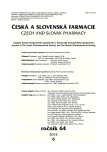Development of the hydrocortisone butyrate qualitative determination method
Authors:
Lesia Savchenko; Valentin Vrakin; Victoriya Georgiyants
Authors place of work:
National university of Pharmacy, Kharkiv, Ukraine
Published in the journal:
Čes. slov. Farm., 2015; 64, 275
Category:
44<sup>th</sup> Conference drug synthesis and analysis
Introduction
Allergic skin diseases are widespread today. According to research, 25% of patients who need help suffer from allergic diseases accompanied by skin manifestations. Also, many children suffer from various allergic skin diseases. For the treatment of allergic dermatitis, drugs for internal application are often combined with drugs for external application. Basic preparations for external treatment of inflammatory dermatoses are ointments with corticosteroids. Severity and speed of the beginning of their anti-inflammatory action is not comparable with any other drugs. The range of manufacturing ointments with corticosteroids in Ukraine varies quite a lot. They are represented by both imported and native dosage forms. Ointments are quickly absorbed, leave no trace on the skin and clothes, do not have any unpleasant smell, but most of them are monocomponent.
This problem may be solved by the preparation and usage of the compounding ointments. The possibility of varying their composition allows to simultaneously exert influence on various links of the pathological process which contributes to a more rapid and active elimination of inflammation in the lesions.
The aim of the study was to develop a scheme of isolation and methods of quantitative determination of hydrocortisone butyrate in the compounding ointment.
Experimental methods
The object of the study was compounding an ointment made on the basis of the factory 1% ointment of hydrocortisone.
For the removal of hydrocortisone butyrate from the compounding ointment, the State Pharmacopoeia of Ukraine, Monograph 2.5.7. “Unsaponifiable matter” was used.
Results and discussion
The main problem during the development of the quantitative determination of hydrocortisone butyrate was to develop a scheme of its release from the compounding ointment which would allow extracting the essential component from the ointment base. To carry out the hydrocortisone butyrate extraction from the ointment, it was proposed to use chloroform after its reheat with an alcoholic solution of potassium hydroxide and further the solution of potassium hydroxide and water laundering until no alkaline solution develops.
To select the optimal method of quantitative determination existing in various pharmacopoeias, these methods were analyzed. The USA Pharmacopoeia and the Chinese Pharmacopoeia recommend to assay hydrocortisone butyrate by HPLC. The Japanese Pharmacopoeia recommends to use UV-spectrophotometry at a wavelength of 254 nm. Our aim was to develop the methods of qualitative determination of hydrocortisone butyrate ointment for the laboratory of quality control of medicines and pharmacies, so our decision was the spectrophotometry method choice. During the analysis it was necessary to take into account that the absorption maxima of hydrocortisone butyrate, nitrofurali and procaini hydrochloridi were in the same range. Therefore, it was necessary to convert hydrocortisone butyrate into a complex that would have maximum absorption in another range.
At first in the basis of the method the reaction with potassium ferotsianide was put. Its positive aspect is that the absorption maximum of the formed complex is significantly different from the absorption maxima of nitrofurali and procaini hydrochloridi. For the further investigation, the reaction with phenylhydrazine was chosen. The resulting complex has the maximum absorption at 410 nm. On the basis of this reaction, a method has been developed for the quantitative determination of hydrocortisone butyrate by spectrophotometry.
Conclusions
The technique of quantitative determination of hydrocortisone butyrate by spectrophotometry after reaction with phenylhydrazine was developed. The next stage of our research will be the validation of this method to prove the possibility of its use in pharmacies.
Conflicts of interest: none.
Lesia Savchenko
National University of Pharmacy
17 Vosstaniya Square, 61001 Kharkiv, Ukraine
e-mail: savchenkolesia@gmail.com
Štítky
Farmacie FarmakologieČlánek vyšel v časopise
Česká a slovenská farmacie

2015 Číslo 6
- Přerušovaný půst může mít významná zdravotní rizika
- Ukažte mi, jak kašlete, a já vám řeknu, co vám je
- Top zaměstnavatelé ve zdravotnictví si hýčkají už studenty
Nejčtenější v tomto čísle
- Antibakteriální účinky přírodních látek – silice
- Povrch těla a tělesná hmotnost dospělé české onkologické populace
- Cholinergický systém srdca
- Organická syntéza, Laboratórny manuál

